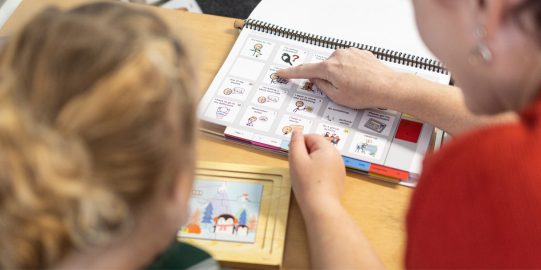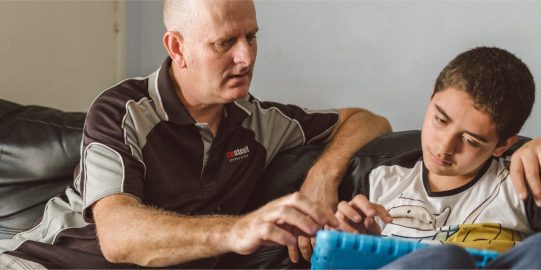Go back to the home page and think about the reason for what you were trying to say.
Rethinking what you want to say
The most important reasons we talk to each other are right on the home page. Each of those reasons has a short message: e.g, “I LIKE THIS” or “SOMETHING’s WRONG.” Those messages on the home page are like paths you can follow. Each path is a different, important reason for talking. Think of the reason you are saying something so that you can select the right path.
When you said, “its time to go to bed,” you were probably sharing information that it’s bedtime. Select “I’m telling you something.” You can follow that path to say “its time to”, “go”, “somewhere in the house”, “bedroom.” If you were just suggesting we go upstairs, then select the green “Let’s go” message and decide where in the house you want to go.
Expressing an opinion
The early simPODD books are full of these pathways to powerful messages. Select the teal “I like this!” to find positive opinions, like funny, favorite, and awesome. “Turn the page” to find more options. If the exact word you wanted isn’t there, just choose a word that works.
Another pathway lets you share negative opinions and comments. Select “I don’t like this” to find words you can use to criticize. Maybe it’s bad, boring, or noisy. “Turn the page” to find messages like “makes me mad” and “annoying.” Notice that “I like this” and “I don’t like this” are the same color: teal. This is because they will be combined into one opinion message over time, in more advanced simPODD page sets.
We often complain. We complain so that something will change. With simPODD, we complain by selecting the blue “Something is wrong.” Follow that pathway to explain the problem. Maybe you have a headache. Select “something is wrong”, then “pain” or “hurts.” These will lead to options for body parts, where you can select “head”. Your message: something’s wrong, my head hurts.
Doing an activity
You can use simPODD to suggest doing an activity, like watching a movie or playing with toys or eating a snack. Select the yellow “I want.” This path lets you select from a variety of popular activities. You can suggest an action by selecting the pink “do something.” This path will give you verbs. Maybe you want your child to COME here and GET shoes so we CAN GO. You can say all this with the “do something” path.
Many children who cannot speak have never been able to ask a question. “I have a question” leads to a path of common early questions. You can ask “what’s happening?” before checking the daily schedule.
Adding more fun into our communication
Many children have never been able to say, “lets’ pretend.” This is a fun and powerful message. There are several paths in simPODD for pretend play. Select “I’m telling a story” or “I’m telling you something.” You can then select “let’s pretend.” This path takes you to the categories, where you can select the specific things you want to pretend about.
There are many quick messages we say to each other, like “hurry up!” and “wait a minute.” These quick messages are found in the gold chat words folder, right on the home page. Polite social comments, like “thank you” and “goodbye”, are in the brown greet and manners folder.
Advancing with PODD
PODD 15 will teach you how to move around the different paths of simPODD. Over time, as your son or daughter begins to use their simPODD, you will move on to more advanced page sets. You will see that simPODD has already taught you the paths and structure of these more complex books. The color cues will stay the same. The pathways of early simPODD books become sentence starters in the advanced books. The later simPODD books will feel simpler because you already know how PODD works. These more advanced books will be more like speaking regular English. In the meantime, your child’s experience with the early simPODD books will have taught them they are people who can comment, complain, praise, suggest, ask questions, pretend play, and tell stories.
Printing a paper simPODD book
The digital app of simPODD is a dynamic display. The screen changes at the touch of a button. It can seem confusing if you weren’t expecting that to happen or haven’t learned where the pathway goes. The paper simPODD books tell you exactly what will happen. Each message that is part of a pathway has a number and a color to tell you what page to turn to. The paper books are really intended for us, the adults. We are the “smart partner” who turns the pages. Consider printing a paper simPODD book as the companion to your digital app. It's like having a roadmap on your simPODD journey.





